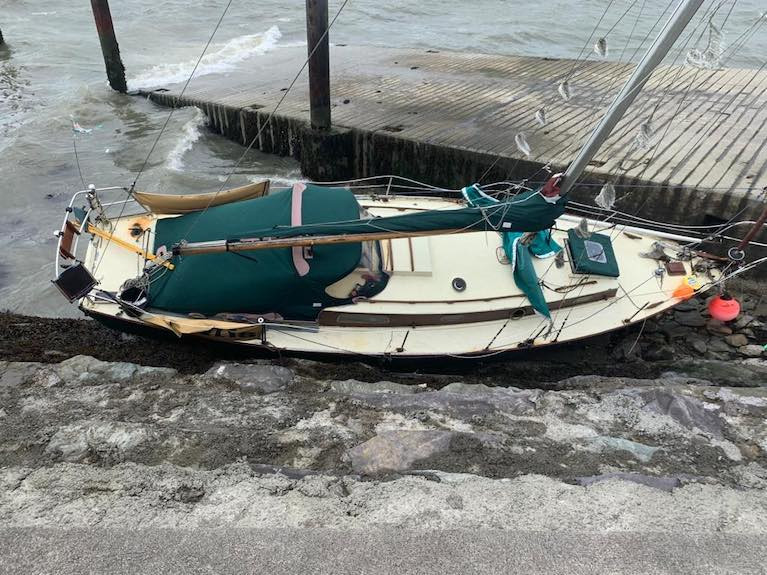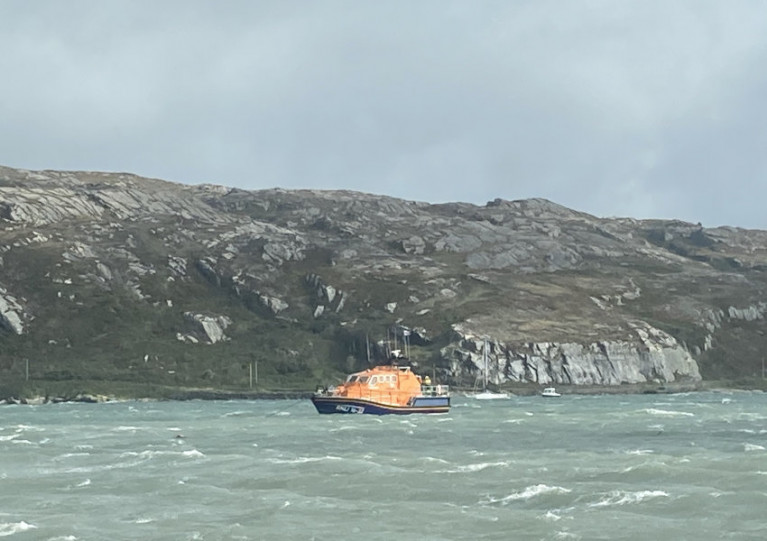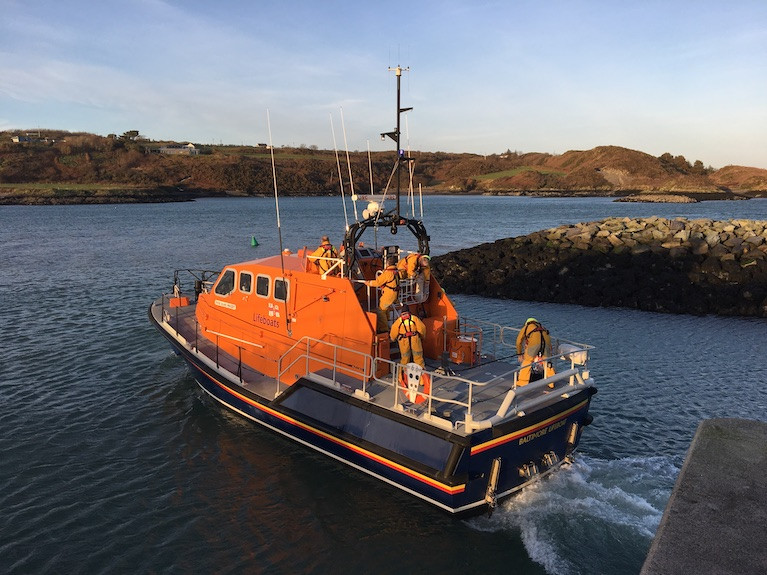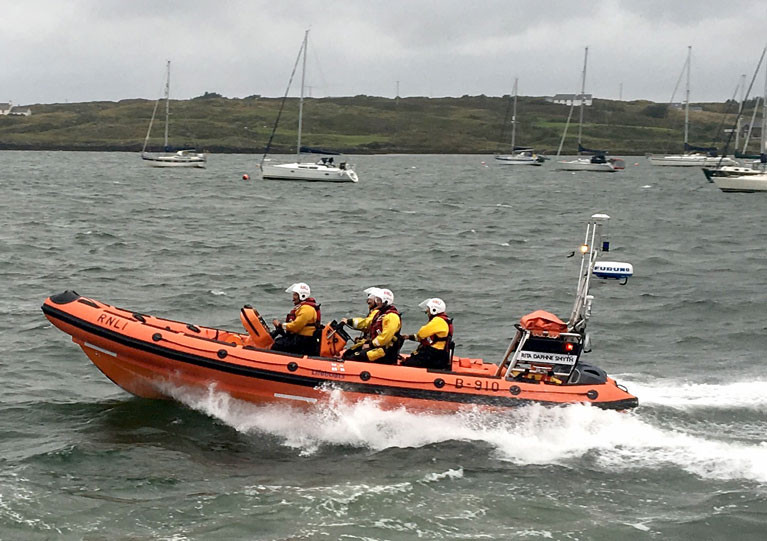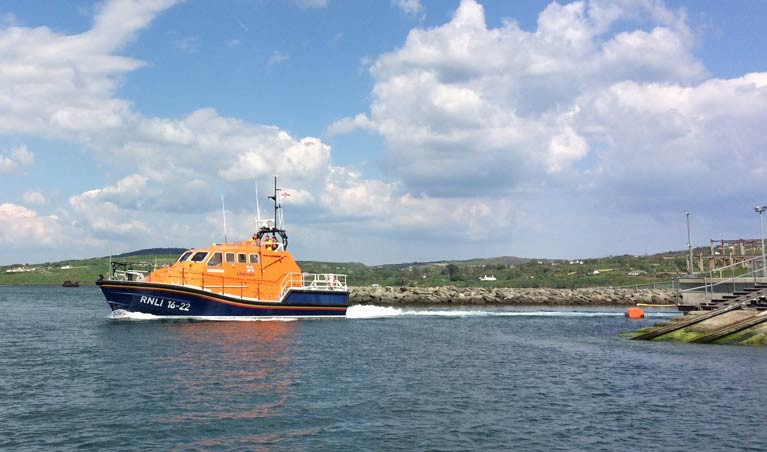Displaying items by tag: Baltimore
Baltimore RNLI on Two Call Outs Within 14 hours
Baltimore RNLI was called out twice in 14 hours to provide two separate medical evacuations from Cape Clear Island off the coast of Baltimore, West Cork.
The first call out happened yesterday evening (Saturday 19 September). The volunteer lifeboat crew launched their all-weather lifeboat at 6.49 pm, following a request from the Irish Coast Guard to provide a medical evacuation (Medivac) to an islander from Cape Clear.
The Baltimore all-weather lifeboat crew arrived at Cape Clear Island at 7.10 pm. After an initial assessment, the voluntary lifeboat crew brought the casualty onboard the lifeboat and they departed the island at 7.14 pm. The lifeboat arrived back to Baltimore Lifeboat Station at 7.42 pm where the casualty was handed over to the care of the HSE ambulance crew.
There were six volunteer crew onboard the lifeboat, Coxswain Kieran Cotter, Mechanic Sean McCarthy and crew members Jerry Smith, Aidan Bushe, David Ryan and Jim Griffiths.
The second call-out came earlier this morning (Sunday 20 September) when at the request of the Irish Coast Guard the volunteer lifeboat crew launched their all-weather lifeboat at 8.24 am, to provide another Medivac to an islander from Cape Clear.
The Baltimore all-weather lifeboat crew arrived at the island at 8.47 am and transported the casualty back to Baltimore, departing Cape Clear at 8.57 am and arriving back at the Lifeboat Station at 9.26 am. The casualty was handed over to the care of the HSE ambulance crew.
On this morning’s call out were five volunteer crew, Coxswain Kieran Cotter, Mechanic Sean McCarthy and crew members Micheal Cottrell, David Ryan and Don O’Donovan. Conditions at sea during both call-outs were calm with a northeasterly wind and no sea swell.
Storm Francis Hits Baltimore Harbour in West Cork
Storm Francis hit the West Cork Harbour of Baltimore today with the town's RNLI lifeboat called out to nearby Crookhaven Bay to two yachts in difficulty on moorings as Afloat reported here this morning.
Pleasure craft in Baltimore Harbour itself were also in difficulty in the storm-force winds.
Last week Storm Ellen felled trees and flooded towns, with Cork receiving the worst battering, and now the arrival of Storm Francis has caused even more damage in some of the worst-hit places.
A RIB broke its mooring in Baltimore. this afternoon but was towed safely back out to sea after some quick thinking seamanship as seen in this reader vid below.
Unfortunately, a classic yacht also broke its moorings in the West Cork marine leisure centre and has been damaged according to eyewitness accounts. See the reader vid below.
Baltimore RNLI’s volunteer crew launched to the aid of two yachts in difficulty in Crookhaven Harbour as Storm Francis passed over West Cork this morning (Tuesday 25 August).
The two vessels, one with four on board and the other with two, were dragging their moorings in the strong Force 9 winds, gusting up to Force 11, and rough sea conditions with a five-metre swell.
RNLI volunteers at the scene launched the smaller Y-boat from the all-weather lifeboat to get close enough to secure extra lines from the yachts to nearby moorings, and helped stead one of the yachts by dropping and extra anchor upwind.
Lifeboat crew member Micheal Cottrell said: “The skippers did the right thing in looking for assistance as soon as they knew their moorings weren’t holding, especially considering the storm hadn’t reached its full force at the time.”
A Status Yellow gale warning remains in place with Met Éireann forecasting cyclonic variable winds to reach gale or strong gale this afternoon, on Irish coastal waters from Carlingford Lough to Valentia to Belfast Lough and on the Irish Sea south of the Isle of Man.
The meteorological service also issued a Small Craft Warning as southeasterly winds were expected reach Force 6 or 7 for a time early this afternoon on coasts from Belfast Lough to Carlingford Lough, and on the Irish Sea north of the Isle of Man.
Baltimore RNLI Called Out Following Activation of a Positioning Beacon off the Coast of West Cork
Baltimore RNLI was launched this afternoon following the activation of an alarm from a positioning beacon off the coast of West Cork.
The volunteer lifeboat crew launched their inshore lifeboat at 4.04 pm following a request from the Irish Coast Guard to help locate an active Emergency Position Indication Radio Beacon (EPIRB) two nautical miles west of the Calf Islands off the coast of West Cork.
Baltimore lifeboat proceeded to the area and started to search under the direction of the Irish Coast Guard and the Irish naval vessel the LÉ Samuel Beckett. Also assisting in the search were Schull Coast Guard and an Irish Coast Guard helicopter. After an extensive search was carried out by all agencies the search was stood down at 6.43 pm and Baltimore lifeboat made its way back to the station arriving at 7.05 pm.
There were four volunteer crew onboard the lifeboat, Helm Pat O’Driscoll and crew members Eoin O’Driscoll, David Ryan and Kieran O’Driscoll. Assisting at the boathouse were Jerry Smith and Marty O’Driscoll. Conditions at sea during the call were calm with a south-easterly force 2-3 wind and 0.5m sea swell.
Speaking following the call out, Pat O’Driscoll, Baltimore RNLI Volunteer Helm said: ‘Thankfully the activation of the alarm today was not due to the loss of a vessel. It is important to ensure the secure fastening of an EPIRB on board a vessel and to regularly check that it is in good working order. With storm Ellen approaching, bringing strong winds and potential coastal flooding in combination with spring tides, the RNLI is urging people to exercise extreme caution. If you think someone is in difficulty at sea or along the coast, call 999 or 112 and ask for the Coast Guard.’
Baltimore RNLI Assists Yacht In Difficulty Off Baltimore Harbour
Baltimore RNLI was called out earlier this morning (Saturday, 15 August) to provide assistance to a yacht in difficulty off Baltimore Harbour in West Cork.
The volunteer lifeboat crew launched their inshore lifeboat at 8.05 am, following a request from the Irish Coast Guard to assist a 37-foot yacht, with three people on board, which had suffered engine failure just off Baltimore Harbour.
The Baltimore inshore lifeboat arrived at the casualty vessel at 8.12 am and voluntary lifeboat crew member Eoin O’Driscoll was put aboard to rig a tow. The inshore lifeboat towed the casualty vessel back to Baltimore Harbour and put them on a mooring off Sherkin Island. Once the casualty vessel was secured, the lifeboat returned to the station, arriving at 8.59 am.
There were four volunteer crew onboard the lifeboat, Helm Micheal Cottrell and crew members Pat O’Driscoll, Eoin O’Driscoll and Kieran O’Driscoll. Conditions at sea during the call were calm with an easterly force 1-2 wind and no sea swell.
Speaking following the callout, Kate Callanan, Baltimore RNLI Volunteer Lifeboat Press Officer said: "The skipper of the yacht did the right thing in requesting assistance as he felt winds were too light to allow him to safely access the harbour. If you get into difficulty at sea or on the coast, call 999 or 112 and ask for the Coast Guard."
The previous day, Friday 14 August, Baltimore's lifeboat crew launched to their second medical evaculation of the week from Sherkin Island – bringing an islander to the mainland and the care of paramedics for further attention.
Baltimore RNLI was called out to provide a medical evacuation this afternoon from Sherkin Island off the coast of Baltimore, West Cork.
The volunteer lifeboat crew, under Coxswain Kieran Cotter, launched their all-weather lifeboat at 3.06 pm, following a request from the Irish Coast Guard to provide medical assistance and evacuation to a woman who had sustained an injury following a fall.
The Baltimore all-weather lifeboat crew arrived at Sherkin Island pier at 3.15 pm and reached the casualty at the same time as a First Responder team who were also in the area. An initial assessment was carried out by one of the First Responders and then the voluntary lifeboat crew, assisted by the First Responder team, transferred the casualty onboard the lifeboat.
The lifeboat then returned to the station in Baltimore and the casualty was handed over to the care of HSE Ambulance crew at 4.30 pm.
Conditions at sea during the call out were calm with a south - south-westerly force 3-4 wind, no sea swell and good visibility.
Speaking following the call out, Kate Callanan, Baltimore RNLI Volunteer Lifeboat Press Officer said: ‘If you find yourself in a medical emergency whilst on an island call 999 or 112 and explain to the operator what the nature of the call is. The operator will then make sure that the call is directed to both the Coast Guard and the National Ambulance Service. We would like to thank the First Responders for assisting in this call and we wish the casualty a speedy recovery.’
Baltimore RNLI Assists Motor Boat in Difficulty
Baltimore RNLI was called out earlier this evening (Friday 7 August) to provide assistance to a motorboat in difficulty at Sherkin Island, off the coast of west Cork.
The volunteer lifeboat crew launched their inshore lifeboat at 6.50 pm, following a request from the Irish Coast Guard to assist an 18ft motorboat, with four people on board, which had broken down in Horseshoe Harbour, Sherkin Island, off the coast of West Cork.
The Baltimore inshore lifeboat arrived at the casualty vessel at 6.54 pm. The owner of the motorboat had dropped an anchor and all occupants were wearing lifejackets. The lifeboat transferred volunteer crew member David Ryan on to the vessel. He established a tow and hauled the anchor, and the lifeboat commenced the tow for Baltimore at 6.59 pm. The lifeboat towed the casualty vessel to its own mooring in Baltimore Harbour and once it was secured the lifeboat returned to the station, arriving at 7.24 pm.
There were four volunteer crew onboard the lifeboat, Helm Micheal Cottrell and crew members Ryan O’Mahony, David Ryan and Eoin O’Driscoll. Assisting at the station were Jerry and Rianne Smith. Conditions at sea were calm with a westerly force 4 wind, a 0.5m sea swell and good visibility.
Speaking following the call out, Kate Callanan, Baltimore RNLI Volunteer Lifeboat Press Officer said: ‘Always remember when going to sea, to carry means of communication. If you get into difficulty at sea or on the coast, call 999 or 112 and ask for the Coast Guard.’
Baltimore RNLI Provides Assistance to Yacht in Difficulty
Baltimore RNLI was called out earlier this afternoon (Monday 27 July) to provide assistance to a yacht in difficulty near Middle Calf Island off the coast of West Cork.
The volunteer lifeboat crew launched their all-weather lifeboat at 4.55 pm, following a request from the Irish Coast Guard to assist a 39-foot yacht, with two people on board, which had suffered engine failure in the area of the Calf Islands off the coast of West Cork.
The Baltimore all-weather lifeboat arrived at the casualty vessel at 5.16 pm. The skipper of the yacht had dropped his anchor however due to strong winds the anchor wasn’t holding. A volunteer crew member from the lifeboat was put aboard to assist in rigging a tow and the lifeboat and casualty vessel were underway heading for Baltimore harbour by 5.25 pm. As they approached the pier in Baltimore, the yacht was brought alongside the lifeboat to make it easier to manoeuvre whilst they berthed at the pier. Once the casualty vessel was secured, the lifeboat returned to the station, arriving at 6.25 pm.
There were seven volunteer crew onboard the lifeboat, Coxswain Kieran Cotter, Mechanic Cathal Cottrell and crew members Aidan Bushe, David Ryan, Micheal Cottrell, Ronnie Carthy and Jim Baker. Conditions at sea during the call very breezy with a north-westerly force 5-6 wind, a 0.5m sea swell and good visibility.
Speaking following the call out, Kate Callanan, Baltimore RNLI Volunteer Lifeboat Press Officer said: ‘The skipper of the yacht did the right thing in asking for assistance as he realised the strong winds and tides at the time would make it difficult to sail back through the narrow channels through the islands. If you get into difficulty at sea or on the coast, call 999 or 112 and ask for the Coast Guard.’
Baltimore RNLI was called out to provide a medical evacuation last night (Sunday 19 July) from Sherkin Island off the coast of Baltimore, West Cork.
The volunteer lifeboat crew launched their all-weather lifeboat at 7.49 pm, following a request from the Irish Coast Guard to provide medical assistance and evacuation to an islander living on Sherkin.
The Baltimore all-weather lifeboat arrived at Sherkin Island pier within a few minutes of launching. The volunteer lifeboat crew went to the location where the casualty was, to assist with transfer and casualty care. Once ready the casualty was brought onboard Baltimore lifeboat and they departed the island at 8.58 pm. The lifeboat returned to the station in Baltimore and handed the casualty over to the care of HSE Ambulance crew at 9.10 pm.
There were five volunteer crew onboard the lifeboat, Coxswain Kieran Cotter, Mechanic Cathal Cottrell and crew members Sean McCarthy, Jerry Smith and Emma Lupton. Conditions at sea during the call out were flat calm in the harbour with a westerly force 3 wind, no sea swell and very good visibility.
Speaking following the call out, Kate Callanan, Baltimore RNLI Volunteer Lifeboat Press Officer said: ‘Baltimore RNLI regularly provides the vital service of medical evacuations (medevacs) for residents and visitors to local islands such as Sherkin, Cape Clear and Heir. If you find yourself in need of medical assistance, call 999 or 112 and ask for the Coast Guard.’
Baltimore RNLI was called out to provide a medical evacuation late last night (Thursday 16 July) from Sherkin Island off the coast of Baltimore, West Cork.
The volunteer lifeboat crew, under Coxswain Kieran Cotter, launched their all-weather lifeboat at 11.50 pm, following a request from the Irish CoastGuard to provide medical assistance and evacuation to a boy who had sustained an injury earlier that day.
The Baltimore all-weather lifeboat crew along with two HSE paramedics arrived at Sherkin Island a few minutes after launching. The paramedics did an initial assessment before the voluntary lifeboat crew brought the casualty onboard the lifeboat.
The lifeboat then returned to the station in Baltimore at 00.21am where the casualty was transferred to the ambulance and brought to hospital.
Conditions at sea during the call out were calm with a westerly force 2-3 wind, no sea swell but visibility was poor.
Speaking following the call out, Kate Callanan, Baltimore RNLI Volunteer Lifeboat Press Officer said: ‘This is the second call out to a medical evacuation on an island for Baltimore lifeboat in the past week. If you find yourself in need of medical assistance whilst at sea or on an island, call 999 or 112 and ask for the Coast Guard. We wish the casualty a speedy recovery.’



























